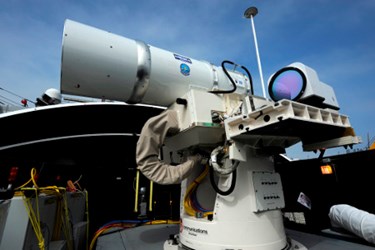US, UK Military Ready Prototypes For Laser Weapon Systems
By Jof Enriquez,
Follow me on Twitter @jofenriq

The United States and United Kingdom militaries have announced separate deals to develop and deploy laser weapons aboard naval ships.
The U.S. Navy's Office of Naval Research (ONR) has sealed a 12-month, $53-million deal with Northrop Grumman to develop a Laser Weapon System Demonstrator (LWSD) through three phases: initial design, ground-testing, and weapons testing at sea aboard a Navy Self Defense test ship, according to the website Scout Warrior (via The National Interest). The contract potentially could be worth as much as $91 million over 34 months, upon ONR's discretion.
"This system employs multi-spectral target detection and track capabilities as well as an advanced off-axis beam director with improved fiber laser technologies to provide extended target engagement ranges. Improvements of high power fiber lasers used to form the laser beam enable the increased power levels and extended range capabilities. Lessons learned, operating procedures, updated hardware and software derived from previous systems will be incorporated in this demonstration," Dr. Tom Beutner, director of the Air Warfare and Weapons branch, ONR, told Scout Warrior.
While the LWSD is a prototype, a similar system called Laser Weapons System (LaWS) has been operational for months aboard an amphibious transport dock in the Persian Gulf, the USS Ponce, according to the website. LaWS uses heat energy from lasers, and has successfully been used to disable or destroy both stationary and moving targets, such as unmanned aerial vehicles (UAV).
ONR also has partnered with Raytheon to install vehicle-based laser weapons in Humvees to shoot down low-flying threats, such as enemy drones.
Lasers represent a legitimate cost-effective weapon system for the U.S. military. For instance, LaWS only costs about $0.59 cents per shot, an amount that is exponentially lower that the hundreds of thousands (or millions) of dollars needed to fire an interceptor missile, such as the Standard Missile-2, according to Scout Warrior, quoting U.S. Navy officials.
Meanwhile, UK's Defence Secretary Michael Fallon confirmed recently that the Ministry of Defence (MoD) has inked a £30 million (US $40 million) contract with a consortium called Dragonfire — led by European missile manufacturer MBDA — to build its own laser-directed energy weapon demonstrator.
MBDA will join with Qinetiq, Leonardo, GKN, BAE Systems, Arke, and Marshall Aerospace and Defence in building the prototype laser weapon, slated for testing aboard a warship in 2019, according to Defense News. During trials, MBDA will assess the laser system's capability to acquire and track targets at range and in varying weather conditions, over land and water.
The UK’s effort to build a laser weapon system is part of a larger program fostered by the Defence Science and Technology Laboratory (DSTL), an executive agency of the MoD, which reportedly also plans to develop radio frequency-directed energy weapons.
